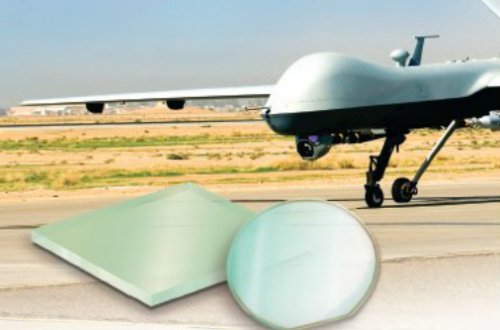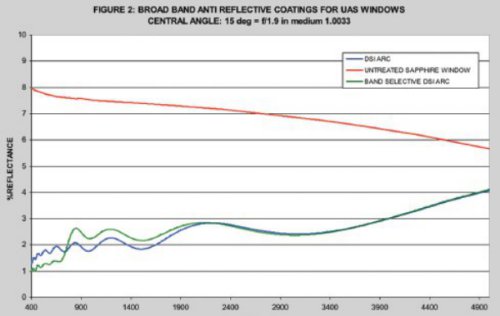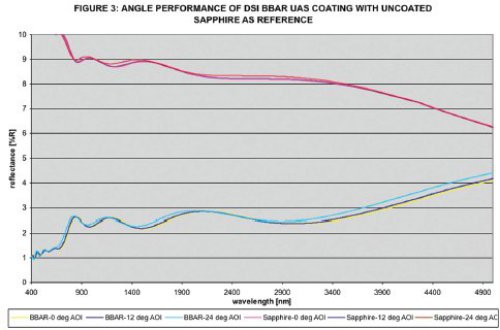This article, written by Eric Kurman in PTB Magazine (Photonics Solutions for the Design Engineer), describes how the new BBAR coatings provide increased transmittance over the wide wavelength range that sapphire allows, permitting technological advances in optical system design. Sapphire optical windows are an excellent fit for the harsh environment and multiple wavelength requirements encountered in UAS service.
Unmanned aircraft systems and their applications are experiencing rapid growth, especially in the area of remote sensing. Advances in propulsion; airframe materials; communications, command and control (C3) systems; cameras and detectors; and image processing are combining to continuously improve UAS capabilities.
Most optical systems used in unmanned aircraft systems function over the visible (VIS) and near-infrared (NIR) wavelength ranges. Increasing in importance is multispectral or hyper-spectral imaging which can combine information from VIS, NIR, mid-wave infrared (MWIR), and long-wave infrared (LWIR) wavelength regions to provide enhanced detection, such as chemical, vehicular, or terrain identification capabilities not available by the use of imaging alone. This article will cover some of the basics of optical thin film coatings as applied to electro-optical systems commonly used in unmanned systems.
Substrate Materials Substrate performance dominates the overall performance of a coated optic. The useful transmittance range of a window material is the most important characteristic, followed by mechanical properties. Various optical glasses are the most durable and versatile of substrates. They have excellent compatibility with coating processes and high hardness.
Coloured or dyed glasses can be used in conjunction with coatings, for example, to block visible light and only permit transmittance in the NIR. One of the most important substrates is synthetic sapphire, Al2O3. Sapphire is extremely hard and durable and has a useful transmittance range extending from 0.3 microns out to nearly 6 microns. The increasing use of sapphire as a substrate for blue LEDs has driven prices down and capabilities up, making it an even more desirable material for optical coatings. Other substrates used in the MWIR include germanium (Ge), silicon (Si), and zinc sulfide (ZnS). Recent advancements in multispectral ZnS, involving hot isostatic pressing, have resulted in water clear substrates that can be used from 0.4 microns all the way to 20 microns. However, ZnS is mechanically inferior to the other materials because its relative softness renders it vulnerable to damage by rain and solid particle erosion. It is a useful substrate material where the combination of subsonic airspeed and the need for multispectral thermal imaging occur together.
Polymer substrates are getting more attention because of the potential for low weight and high strength-to-weight ratio. There is a wide variety of polymer resins available, though many of them are poorly suited to vacuum deposition processes because of plasticizers, mold release agents, and mold flow agents added to the resin formulation. Care must be taken by the coating designer to identify metallizing grade resins. Many high-performance plastics such as polycarbonate (PC), polyetheretherketone (PEEK), and polyimide (PI) are compatible with thin-film deposition processes. Polymer substrates can pose additional challenges because of their high thermal expansion coefficient compared to the dielectric materials used in coatings.
Coating Composition and Properties Specialized optical interference coatings provide enhanced transmittance or reflectance in desired in-band spectral regions. This usually occurs at the expense of transmittance or reflectance in out-of-band regions where no performance requirement exists. Most durable thin film coatings today are made using sputter deposition, a plasma-based physical vapor deposition technique. Sputtering results in metal oxide coatings that have excellent adhesion and durability. Thin-film interference coatings are made using alternating layers of low- and high-refractive index materials.
Silicon dioxide (SiO2) is the most common and most practical low-index material used in sputtered coatings, although higher-index aluminum oxide (Al2O3) can be used in some applications. Various high-index materials are used in sputter deposition including zirconium dioxide (ZrO2), titanium dioxide (TiO2), niobium pentoxide (Nb2O5), and tantalum pentoxide (Ta2O5). Another physical vapor deposition (PVD) technique is evaporation, which can be done using electron-beam or resistance heating. Evaporated material structures are often softer and have less adhesion than sputtered coatings; however, the use of evaporation gives the coating producer access to materials that would be difficult or uneconomical to produce by sputtering. Ultimately, the system designer and coating manufacturer have to converge on a set of requirements that includes optical and durability performance, and this drives material selection.
Coating Rules of Thumb With thin-film design software becoming cheaper and more widespread, some system designers also take on the coating design task. In general, a coating obtained by using the software optimize feature will fall short of one produced by a skilled designer in the areas of tolerance and manufacturability. In either case, there are a few important rules of thumb to consider regarding coating performance.
Coating features (the wavelength at which peaks and valleys occur, band location, etc.) will shift toward lower wavelengths as the angle of incidence (AOI) is increased. This means that bandwidth and tolerance values need to be adjusted to take into account the wavelength shift created by the AOI range. The amount of wavelength shift is a function of the coating design and the materials used. A design with a larger proportion of high-index materials will show less angle shift than one dominated by low-index materials. To a first approximation, coatings behave identically with both s- and p-polarized light at zero AOI. Polarization-specific effects occur at non-zero AOI with diverging values for the reflectance of the s- and p-polarized components. In the case of UAS imaging systems, designers try to minimize polarization effects since the imagers are not polarization sensitive.
In other optical coating applications, such as polarizing beam-splitters, the polarization effects can be exploited to attain a system goal. Antireflection coatings (AR, ARC) show the greatest reduction in reflectance at a single wavelength or over a very narrow wavelength range. In general it is difficult to attain very low reflectance over more than a 2X range in wavelength. In order to get very broadband performance, the coating designer must strike a compromise between reflectance level and bandwidth. This is the approach used by Deposition Sciences, Inc. (DSI) in designing broadband antireflection (BBAR) coatings for UAS application. The graph in Figure 2 shows BBAR coating performance with a cone-angle average of fifteen degrees. Figure 3 indicates the angle performance of new UAS BBAR coatings from DSI.
Environmental Performance and Specifications
Optics on UAS can be subject to demanding environmental requirements, not only in the service environment but also in field deployment. Airborne service requirements include extremes of temperature, exposure to fuels, chemicals, solvents, foreign object debris (FOD) during ground operations, in-flight hazards such as dust and grit impact, and meteorological (rain, hail) impact. Field deployment risks include all the above plus conditions specific to sea or land exposure such as salt fog, humidity, mold and mildew, and handling during maintenance.
EMI/RFI and Conductive Coatings Conductive coated optics are often part of the EMI/RFI design of a sensing system. The requirements could be to limit emissions, to prevent onboard systems from interfering with one another, or to address an electronic countermeasures (ECM) threat from an adversary. The transparent conductive oxide (TCO) thin-film materials are often used to provide electrical conductivity on an optical surface.
The most well known of these is indium-tin oxide or ITO, although various other materials are available. ITO has DC resistivity as low as 2 to 4 times 10-6 Ohm-m, but shows increasing free-carrier absorptance as the wavelength increases. This effect starts to appear as soon as 1 to 1.2 microns in the NIR; in the MWIR, ITO behaves as a free electron metal. For MWIR and LWIR use, conductive grids are still the main choice for RF rejection if system considerations permit. At present, there is no known material with adequate infrared (MWIR, LWIR) transparency and adequate electrical conductivity for electromagnetic shielding.
Surface Quality and Defect Density Surface quality is often called out using the MIL-C-675C and MIL-F-48497 terminology as a scratch and dig set of numbers. These describe the maximum allowable defect size with a number of qualifications such as defect density. It should be noted that MIL-C-675C and MIL-PRF-13830B are active specifications while MIL-F-48497 and MIL-F- 48616 are inactive meaning that they are intended to be used to support or reprocure existing items. Characterization of defect density is an active area of development because of rapid advances in detector and imager technology.
Optics near the focal plane of a detector are often poorly described by conventional scratch/dig metrics, and this application is occurring more frequently. Applying the actual lighting and observation standards described by MIL specs often confuses users, who perceive a poor quality of inspection technique and may be surprised by the allowed defects. Also, most producers and consumers of optics utilize more stringent inspection procedures internally in order to drive process improvement and to characterize optics more thoroughly than the MIL spec standard requires. However, the MIL spec defect ratings are perfectly adequate for optics used far from a focal plane and in the MWIR/LWIR. In the case of more demanding technical requirements, a detailed discussion is beneficial between system designers and optics producers.

BBAR thin film coatings are environmentally stable and perform to MIL-C48947 and MIL-F-48816 standards
Conclusion Unmanned aircraft systems and their applications are an attractive new growth area for advanced optics, which are at the heart of UAS capabilities. Multispectral imagers and optical systems that image in multiple wavelength ranges are increasingly being used. Sapphire optical windows are an excellent fit for the harsh environment and multiple wavelength requirements encountered in UAS service. As shown, the new BBAR coatings provide increased transmittance over the wide wavelength range that sapphire allows, permitting technological advances in optical system design.
Eric W. Kurman is Engineering Manager & Sr. Program Manager, Deposition Sciences, Inc. (Santa Rosa, CA).
Source: PTB Magazine


